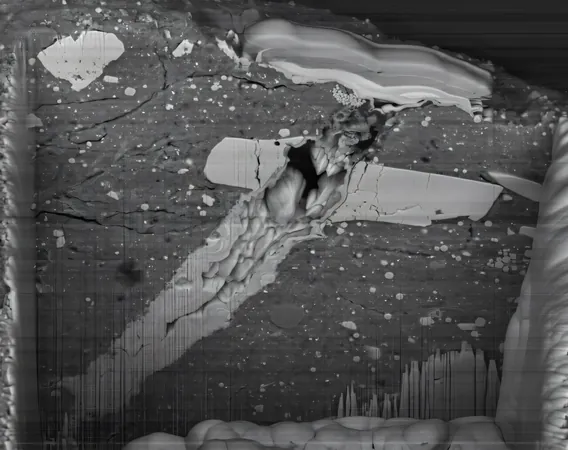
Unlocking the Secrets of Asteroid Bennu: A Journey through Time and Space
2025-08-22
Author: Emma
Asteroid Bennu: A Cosmic Time Capsule
Asteroid Bennu, the target of NASA's groundbreaking OSIRIS-REx mission, is a captivating blend of materials that have traveled across the solar system and beyond. This cosmic artifact encapsulates billions of years of transformation, shaped by water interactions and the harsh conditions of space.
Astounding New Discoveries from Sample Analysis
Recent revelations stem from three compelling studies that analyzed samples delivered to Earth by OSIRIS-REx in 2023. Spearheaded by the University of Arizona's Lunar and Planetary Laboratory, this global research collaboration offers a fresh look into the history of this remarkable asteroid.
Jessica Barnes, an associate professor and lead investigator, expressed her excitement: "This is work you just can't do with telescopes. It's thrilling to uncover secrets of an asteroid that has been a dream target for our exploration efforts."
The Parent Asteroid's Origins and Transformations
Bennu originated from a larger parent asteroid that fragmented due to a catastrophic collision in the asteroid belt between Mars and Jupiter. This parent body held diverse materials from the solar system's formation over 4 billion years ago, possibly forming in the outer solar system beyond the giant planets.
Barnes explained the dynamic history: "We believe this parent body was repeatedly struck and reassembled, giving us fragments of its complex past."
The Treasure Trove of Stardust and Organic Materials
The OSIRIS-REx samples revealed an exciting abundance of stardust—ancient particles from long-gone stars. Thanks to advanced isotopic analysis at the University of Arizona's Kuiper-Arizona Laboratory for Astromaterials Analysis, researchers could identify these rare grains, providing a snapshot of the early solar system's composition.
In addition to stardust, scientists discovered unique organic materials likely formed in the cold depths of interstellar space, showcasing the diversity of Bennu's composition.
Comparative Studies: Bennu vs. Other Asteroids
Intriguingly, the chemical and isotopic similarities between Bennu and Japan's Hayabusa 2 asteroid, Ryugu, point to a shared history in the early solar system. Yet, differences observed may suggest that the materials in this area evolved over time, highlighting a complex interplay in their formation.
The Role of Water in Bennu's Evolution
A second study delved into the hydrothermal processes that shaped Bennu’s parent asteroid. Researchers posited that icy materials from the outer solar system melted over time, interacting with silicate minerals at room temperature, leading to fascinating chemical reactions.
Tom Zega, director of the Kuiper-Arizona Laboratory, noted, "This liquid-water interaction initiated chemistry that led to the minerals we see today, created billions of years ago during the solar system's infancy."
Space Weathering: Bennu’s Ongoing Transformation
A final paper revealed striking evidence of micrometeorite impacts on Bennu's surface, showcasing a phenomenon known as "space weathering." This process occurs at an accelerated rate due to Bennu's lack of a protective atmosphere, consistently reshaping its exterior.
Lindsay Keller of NASA remarked, "These impacts are crucial for understanding how materials evolve over time in space. The study challenges conventional wisdom regarding the speed of these weathering processes."
Why Sample Return Missions Matter
Asteroids like Bennu serve as remnants of planetary formation, holding keys to our solar system's history. However, many meteorites that land on Earth may not accurately represent their asteroidal counterparts. Zega emphasized the critical importance of missions like OSIRIS-REx, stating, "These sample returns provide invaluable insights that terrestrial meteorites cannot offer, ensuring we uncover our origins in the universe."









 Brasil (PT)
Brasil (PT)
 Canada (EN)
Canada (EN)
 Chile (ES)
Chile (ES)
 Česko (CS)
Česko (CS)
 대한민국 (KO)
대한민국 (KO)
 España (ES)
España (ES)
 France (FR)
France (FR)
 Hong Kong (EN)
Hong Kong (EN)
 Italia (IT)
Italia (IT)
 日本 (JA)
日本 (JA)
 Magyarország (HU)
Magyarország (HU)
 Norge (NO)
Norge (NO)
 Polska (PL)
Polska (PL)
 Schweiz (DE)
Schweiz (DE)
 Singapore (EN)
Singapore (EN)
 Sverige (SV)
Sverige (SV)
 Suomi (FI)
Suomi (FI)
 Türkiye (TR)
Türkiye (TR)
 الإمارات العربية المتحدة (AR)
الإمارات العربية المتحدة (AR)